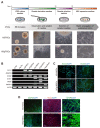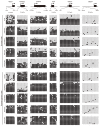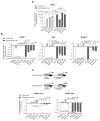Alteration of Genomic Imprinting Status of Human Parthenogenetic Induced Pluripotent Stem Cells during Neural Lineage Differentiation
- PMID: 30836722
- PMCID: PMC6457707
- DOI: 10.15283/ijsc18084
Alteration of Genomic Imprinting Status of Human Parthenogenetic Induced Pluripotent Stem Cells during Neural Lineage Differentiation
Abstract
Background and objectives: Genomic imprinting modulates growth and development in mammals and is associated with genetic disorders. Although uniparental embryonic stem cells have been used to study genomic imprinting, there is an ethical issue associated with the destruction of human embryos. In this study, to investigate the genomic imprinting status in human neurodevelopment, we used human uniparental induced pluripotent stem cells (iPSCs) that possessed only maternal alleles and differentiated into neural cell lineages.
Methods: Human somatic iPSCs (hSiPSCs) and human parthenogenetic iPSCs (hPgiPSCs) were differentiated into neural stem cells (NSCs) and named hSi-NSCs and hPgi-NSCs respectively. DNA methylation and gene expression of imprinted genes related neurodevelopment was analyzed during reprogramming and neural lineage differentiation.
Results: The DNA methylation and expression of imprinted genes were altered or maintained after differentiation into NSCs. The imprinting status in NSCs were maintained after terminal differentiation into neurons and astrocytes. In contrast, gene expression was differentially presented in a cell type-specific manner.
Conclusions: This study suggests that genomic imprinting should be determined in each neural cell type because the genomic imprinting status can differ in a cell type-specific manner. In addition, the in vitro model established in this study would be useful for verifying the epigenetic alteration of imprinted genes which can be differentially changed during neurodevelopment in human and for screening novel imprinted genes related to neurodevelopment. Moreover, the confirmed genomic imprinting status could be used to find out an abnormal genomic imprinting status of imprinted genes related with neurogenetic disorders according to uniparental genotypes.
Keywords: Genomic imprinting; Induced-pluripotent stem cells; Neural stem cells; Parthenogenetic cells; in vitro model.
Conflict of interest statement
The authors indicate no potential conflicts of interest.
Figures




Similar articles
-
Conversion of genomic imprinting by reprogramming and redifferentiation.J Cell Sci. 2013 Jun 1;126(Pt 11):2516-24. doi: 10.1242/jcs.122754. Epub 2013 Mar 22. J Cell Sci. 2013. PMID: 23525019
-
Generation of Mouse Parthenogenetic Epiblast Stem Cells and Their Imprinting Patterns.Int J Mol Sci. 2019 Oct 31;20(21):5428. doi: 10.3390/ijms20215428. Int J Mol Sci. 2019. PMID: 31683583 Free PMC article.
-
Epigenetic alteration of imprinted genes during neural differentiation of germline-derived pluripotent stem cells.Epigenetics. 2016 Mar 3;11(3):177-83. doi: 10.1080/15592294.2016.1146852. Epub 2016 Mar 10. Epigenetics. 2016. PMID: 26962997 Free PMC article.
-
Aberrations of Genomic Imprinting in Glioblastoma Formation.Front Oncol. 2021 Mar 12;11:630482. doi: 10.3389/fonc.2021.630482. eCollection 2021. Front Oncol. 2021. PMID: 33777782 Free PMC article. Review.
-
Imprinting of the mouse Igf2r gene depends on an intronic CpG island.Mol Cell Endocrinol. 1998 May 25;140(1-2):9-14. doi: 10.1016/s0303-7207(98)00022-7. Mol Cell Endocrinol. 1998. PMID: 9722161 Review.
Cited by
-
Generation of human androgenetic induced pluripotent stem cells.Sci Rep. 2020 Feb 27;10(1):3614. doi: 10.1038/s41598-020-60363-1. Sci Rep. 2020. PMID: 32109236 Free PMC article.
-
Selection of iPSCs without mtDNA deletion for autologous cell therapy in a patient with Pearson syndrome.BMB Rep. 2023 Aug;56(8):463-468. doi: 10.5483/BMBRep.2022-0204. BMB Rep. 2023. PMID: 37156631 Free PMC article.
References
LinkOut - more resources
Full Text Sources

